There are two basic options when it comes to amplifying or recording your acoustic guitar. The first option is to position yourself properly in front of a microphone. This option can have its advantages. However, it is often more practical to install a pickup to allow you to plug in your guitar via instrument cable. There are several different styles and factors to consider when choosing an acoustic guitar pickup. There’re also different tone characteristics that each can offer, but we’ll dive more into all that below.
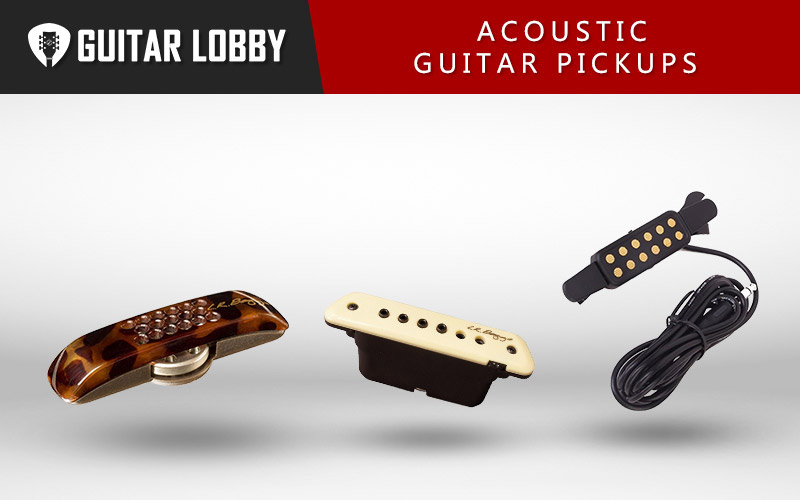
I’ll start this article by reviewing the best acoustic guitar pickups at different price points. If you’d rather start by reading up more on the general ins and outs of acoustic guitar pickups before diving into product reviews, you can see our comprehensive acoustic guitar pickup buying guide at the bottom of the page.
| Name of Product | Image of Product | Description | Price Range | Full Review |
|---|---|---|---|---|
| 1. L.R. Baggs Anthem (Best Overall) | 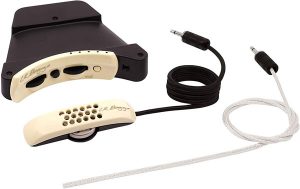 | Type: Under-saddle transducer with microphone Design: Active | $300 | Read Full Review Below |
| 2. K&K Pure Mini (Best Under $100) | 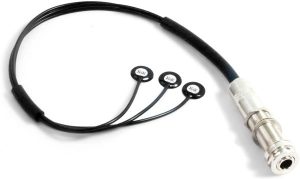 | Type: Contact transducer Design: Passive | $100 | Read Full Review Below |
| 3. Fishman Neo-D (Best Value) | 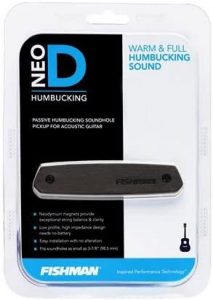 | Type: Magnetic humbucker Design: Passive | $80 | Read Full Review Below |
| 4. LUVAY Transducer (Budget Pick) | 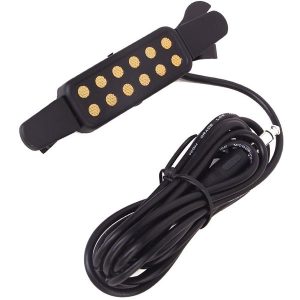 | Type: Soundhole transducer Design: Passive | $10 | Read Full Review Below |
| 5. KNA NG-1 (Best for Nylon String Acoustic Guitars) | 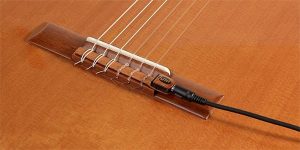 | Type: Under-saddle transducer Design: Passive | $70 | Read Full Review Below |
| 6. LUVAY Piezo | 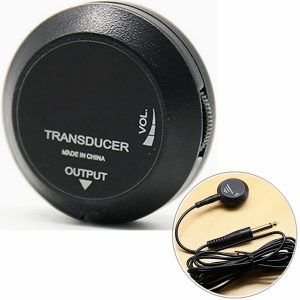 | Contact-vibrational, soundboard transducer Design: Passive | $15 | Read Full Review Below |
| 7. HDE P39 Pickup | 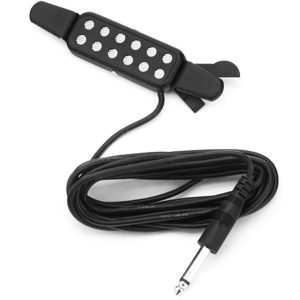 | Type: Soundhole transducer Design: Passive | $10 | Read Full Review Below |
| 8. Seymour Duncan Woody HC | 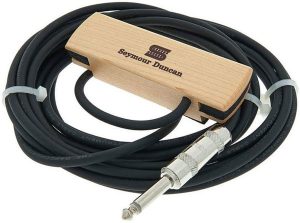 | Type: Magnetic soundhole Design: Passive | $60 | Read Full Review Below |
| 9. Amumu SBT-10 Trans-HD | 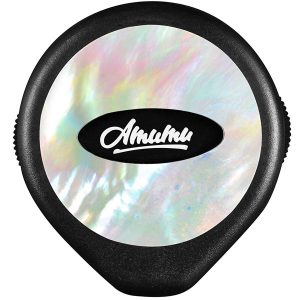 | Type: Contact-vibrational, soundboard transducer Design: Passive | $25 | Read Full Review Below |
| 10. Donner TP-1 | 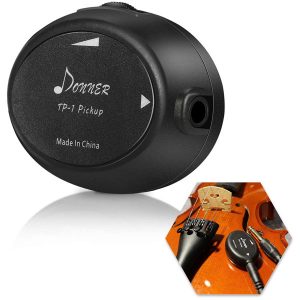 | Type: Piezoelectric contact-vibrational transducer Design: Passive | $15 | Read Full Review Below |
| 11. Fishman Rare Earth Humbucker Acoustic Pickup | 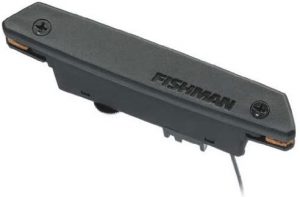 | Type: Combination of magnetic humbucker and active electronic transducer Design: Active, requires 3V lithium or (2) 1.5V LR44 silver oxide batteries | $190 | Read Full Review Below |
| 12. Fishman Matrix Infinity Pickup | 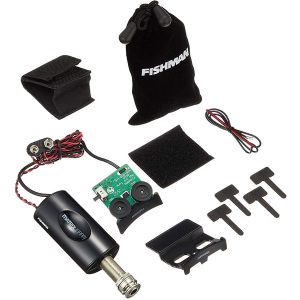 | Type: Under-saddle transducer Design: Active, requires 9V battery | $180 | Read Full Review Below |
| 13. L.R. Baggs M1 | 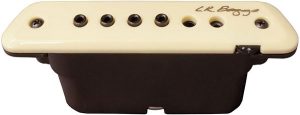 | Type: Magnetic soundhole Design: Active, requires 3V lithium battery | $200 | Read Full Review Below |
| 14. L.R. Baggs Lyric Acoustic Guitar Pickup | 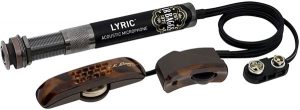 | Type: Microphone Design: Active, requires 9-volt battery | $200 | Read Full Review Below |
| 15. L.R. Baggs M80 | 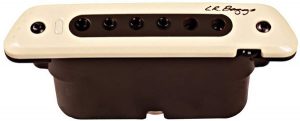 | Type: Magnetic with proprietary free-floating humbucking coil Design: Active-passive, requires CR2032 lithium battery | $250 | Read Full Review Below |
| 16. Guild Guitars DeArmond Tone Boss | 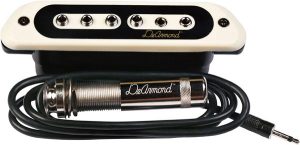 | Type: Magnetic humbucker Design: Passive | $85 | Read Full Review Below |
| 17. Ginean Acoustic Guitar Pickup | 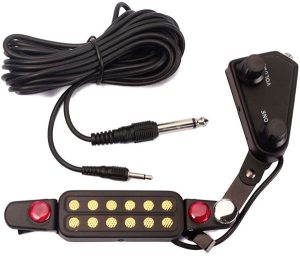 | Type: Magnetic Design: Passive | $15 | Read Full Review Below |
Here Are the Best Acoustic Guitar Pickups
1. L.R. Baggs Anthem (Best Overall)
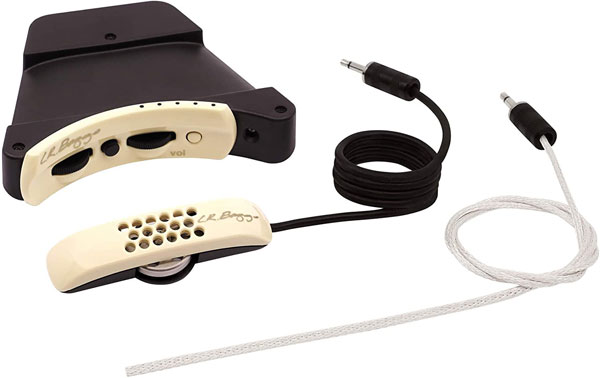
| Estimated price | $300 |
| Type | Under-saddle transducer with microphone |
| Design | Active |
| Preamp | Volume, battery check, mic trim, preset crossover, phase inversion, mix |
| Cable length | Not applicable |
| Installation | Moderate to difficult |
My Review: L.R. Baggs offers several innovative acoustic guitar pickups at different price points. The Anthem is the company’s high-end offering. It is the epitome of acoustic guitar pickup technology that already includes a built-in preamp. This is the pickup that you’ve got to have if you’re dead serious about turning your acoustic guitar into a live concert-ready gigging instrument.
The Anthem is a multisource pickup. It combines the remarkable sound-amplification capabilities of an under-saddle transducer with the great sound pick-up capabilities of an internal guitar microphone. The transducer uses L.R. Baggs’ proprietary Element system that provides excellent body articulation and sensitivity, while also offering the most dynamic range. It focuses more on the low frequency range. You get a device that can go head-to-head with performance electric guitars. This pickup features L.R. Baggs’ revolutionary TRU MIC technology. It has an integrated noise-canceling technology that gets rid of the boxy or honky sound coming from your guitar’s soundbox. It complements the Element system by focusing on the frequency range of the guitar.
The preamp provides several controls, allowing you to shape the kind of tone that you want your guitar to produce. The only tricky aspect of the Anthem is its installation. Like many under-saddle systems, it is best to get a professional to install the Anthem in your guitar. Not only do you need to install the transducer, but you will also have to install the TRU MIC high-fidelity microphone. It is also worth mentioning that the Anthem has a proprietary mounting system that newbies may not be familiar with.
Bottom Line: The remarkable performance and exceptional quality of the L.R. Baggs Anthem acoustic guitar pickup makes its hefty price tag look like a steal. It’s the closest thing you can get to a high-performance electric guitar.
2. K&K Pure Mini (Best Under $100)
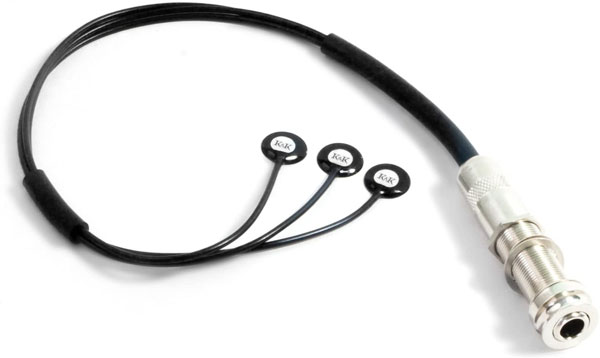
| Estimated price | $100 |
| Type | Contact transducer |
| Design | Passive |
| Preamp | None |
| Cable length | 8 inches |
| Installation | Moderate |
My Review: It is exciting to know that some companies are continuously innovating. One such company that I admire in the world of guitar pickups is K&K. The brand’s Pure Mini is such a joy to behold and even more magical when already installed in your guitar.
It is quite unbelievable how powerful these three very small transducers can be. They pick up the vibrations coming from the bridge plate whenever you play the strings. At first glance, they may work like an under-saddle system. However, there is a big difference in their design. Under-saddle pickups lie a lot closer to the guitar strings, being sandwiched between the saddle and the bridge. The Pure Mini works farther below the bridge on the underside. Each transducer was designed to pick up vibrations from a pair of guitar strings. These transducers also ‘listen’ to the area surrounding the bridge.
You’ve got to check the Pure Mini yourself to believe it. The sound is rich, well-balanced, warm, and full. It is never trebly or thin. The only thing that can discourage you from getting the Pure Mini is its installation. It is relatively easy if you already have a built-in hole in your guitar to pass the cable through and mount the port. If not, then you need to drill. If you’re not confident about it, get a professional. It’s the only way you can unlock the wonderful transducing capabilities of the Pure Mini.
Bottom Line: The K&K Pure Mini offers the best combination of acoustic-electric performance, transducer innovation, quality design and construction, and affordability. It can be tricky to install, but the possibilities are simply endless once you get the device up and running. Overall, I would say that this is the best acoustic guitar pickup under 100 dollars.
3. Fishman Neo-D Humbucker (Best Value)
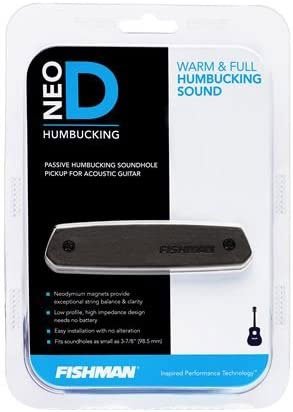
| Estimated price | $80 |
| Type | Magnetic humbucker |
| Design | Passive |
| Preamp | None |
| Cable length | 9 feet |
| Installation | Easy |
My Review: The Fishman Neo-D is what many seasoned songwriters and veteran guitar players use to transform their ordinary steel string acoustic guitar into a concert-ready electric guitar. The futuristic design is like no other, lending your acoustic guitar the kind of aesthetics that it needs to be at par with performance-driven electric guitars at a price that will never create a gaping hole in your wallet.
The Neo-D features a powerful neodymium magnet; hence, the name. I appreciate the humbucking design of the pickup as it helps eliminate the characteristic hum and feedback that typically occurs with magnetic single-coil soundhole pickups. What I found fascinating is the sparkling clarity of the sound. The sound is heavier, darker, and louder; perfect for those instances when you want to play rock and the blues. It’s very well-balanced and has a richer and fuller tone than its single-coil version.
I really mean it when I say that this pickup is a breeze to install. There’s no need to bring out the drill. You can clip the device on the edge of the soundhole and get to playing straight away. The port lets you connect your guitar to any rig or even a laptop, so you can shape the sounds a lot better. This is a pickup that never compromises on its ability to give you a phenomenal sound at a price that is justifiable.
Bottom Line: The Fishman Neo-D may not have a built-in amplifier. However, it’s still one of the best acoustic guitar pickups you can ever use on a steel string guitar because of its ease of installation and excellent sound characteristics.
4. LUVAY Transducer (Budget Pick)
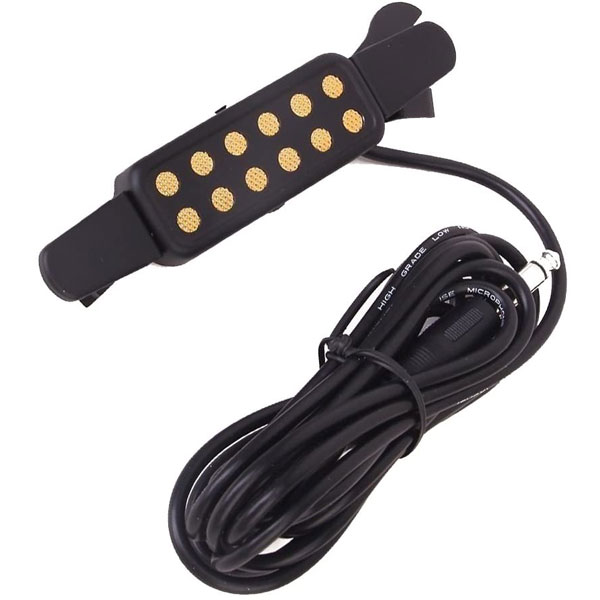
| Estimated price | $10 |
| Type | Soundhole transducer |
| Design | Passive |
| Preamp | None |
| Cable length | 10 feet |
| Installation | Easy |
My Review: This pickup is perfect for guitarists who want a very simple yet effective solution to bring out the best in their guitars. Some of the things I like about this pickup are its ease of installation, hassle-free operation, and astonishing performance. What I find amazing is the simplicity of the pickup’s design. Six pairs of highly sensitive transducers pick up the vibrations of the guitar string and then turn these into electrical signals. There is no drilling required. You can easily clip the device on the edge of your guitar’s soundhole and connect its 10-foot cable to your amplifier.
There is a bit of feedback if you’re not careful with your settings. The good news is that the sound that this pickup produce is close to what your unplugged acoustic guitar would make. The difference? It’s louder and fully capable of giving you that gig jam you’ve been wanting for so long. I was surprised by the fact that there were no annoying hums. The sound may not be comparable to what high-end pickups with built-in preamps provide. However, it has got to be one of the most enjoyable sounds I have ever heard for a price that many of us would consider a real bargain.
Bottom Line: The LUVAY Transducer Acoustic Guitar Pickup is the best choice for anyone who wants a very simple yet equally effective solution to transforming the acoustic guitar into a performance-ready guitar. This is a small device that has a small price yet very big on what it can produce.
5. KNA NG-1 (Best for Nylon String Acoustic Guitars)
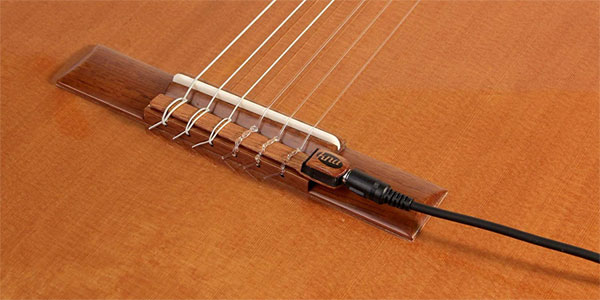
| Estimated price | $70 |
| Type | Under-saddle transducer |
| Design | Passive |
| Preamp | None |
| Cable length | 8 feet |
| Installation | Easy |
My Review: The NG-1 acoustic guitar pickup is not the easiest device you can install on your guitar. However, it is very simple enough that you will never have to bother about sourcing a special drill for a guitar anymore. All it needs is the loosening of the strings so that you can insert the thin piezoelectric transducer in front of the saddle and on top of the bridge. There’s no need for adhesives either. The tension on the strings will keep the device in place. The design also makes it very inconspicuous. No one will ever think that you have a pickup installed if you don’t plug the cable.
What I find fascinating about this KNA product is that it’s designed specifically for nylon string acoustic guitars. The positioning of the pickup allows for the more efficient pickup of nylon string vibrations. And the sound that it produces is simply amazing. It is loud and warm. It amplifies the sound of the nylon strings in a very natural way. I find it very special when playing folk and classical songs. It is soft, yet with a characteristic tone that makes a beautiful melody and harmony.
If you’re worried about the NG-1 changing the nylon strings’ break angle, don’t. This pickup relies on its low profile to make sure that the basic structure of your bridge remains unchanged.
Bottom Line: While the NG-1 is not the least expensive in this list, it does provide specificity to nylon string acoustic guitars. This device is very easy to install and can provide you with a more beautiful sound from your guitar.
6. LUVAY Piezo Acoustic Guitar Pickup
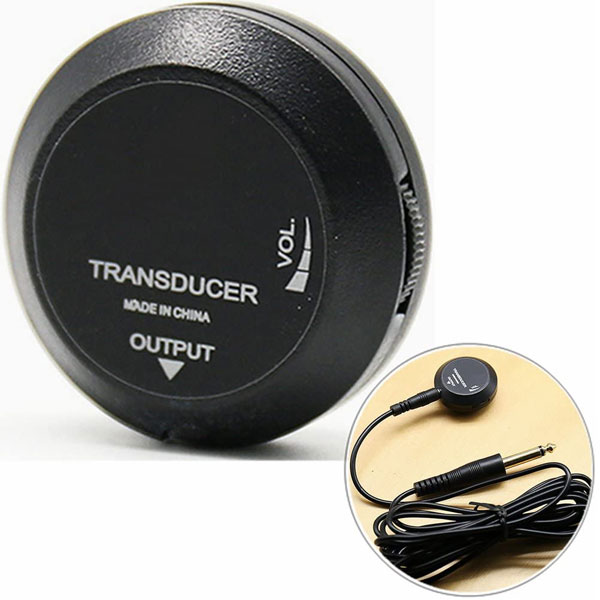
| Estimated price | $15 |
| Type | Contact-vibrational, soundboard transducer |
| Design | Passive |
| Preamp | None |
| Cable length | 10 feet |
| Installation | Easy |
My Review: I’m sure you will also love the LUVAY Piezo in the same way I did. Maybe even more. I find the design of this acoustic guitar pickup to be very interesting. It looks like a streamlined miniature hockey puck that has a round dial on the side. Installing this small contact transducer is as easy as removing the cover of the double-sided adhesive patch under the device. You can then stick this on the body of the guitar. The only downside is that you will have an odd-looking disc on your guitar that can undermine your guitar’s aesthetics.
It’s a small price to pay, considering you will not be paying $20 for this pickup. One thing I must emphasize is that the device doesn’t come with a preamp. However, don’t fret too much. LUVAY was kind enough to incorporate a volume adjustment in the device. It is a neat solution for adjusting the volume of the sound produced by the guitar.
As far as the sound quality goes, I find the sound amplified by this transducer to be surprisingly good. I had doubts that a device this small can produce crisp and clear sounds. It also doesn’t have that hum that we have come to associate with magnetic pickups. The accompanying cable is perfect for connecting to an external guitar amplifier or even a sound mixer. And if you prefer working on your laptop, then connecting the LUVAY Piezo is easy.
Bottom Line: The LUVAY Piezo is the perfect acoustic guitar pickup for people who want effortless installation without compromising on the overall quality of the sound. If you’re not bothered by having a small disc-shaped object on your guitar, then this one is for you.
7. HDE P39
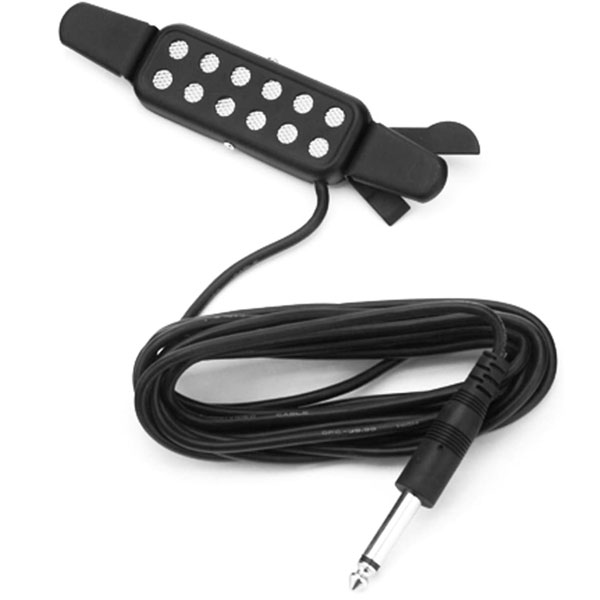
| Estimated price | $10 |
| Type | Soundhole transducer |
| Design | Passive |
| Preamp | None |
| Cable length | 9 feet |
| Installation | Easy |
My Review: First-time acoustic guitar players will love the HDE P39 pickup. At less than $10, the P39 could very well be one of the most inexpensive pickups you can ever put in your acoustic guitar. And while it is easy to say that its price reflects its mediocre quality sound, you’d be surprised as I did.
Of course, it is unreasonable to expect the P39 to perform at the same level as high-end acoustic guitar pickups. It has this scratchy sound that may put off some people. For its price, I think it is still acceptable to get such sound quality. I have seen some higher-priced pickups that are worse when it comes to the quality of the sound that they produce.
Most of the complaints you will see on e-commerce sites about this product is that it hums. My guess is that these guitarists are playing their guitar very close to the guitar amplifier. The P39 doesn’t have a built-in amp. That is why you’ve got to plug it into an external amp. If you’re too close to this device, then it is very likely that you will have the characteristic feedback or mains hum. I find playing the guitar at a considerable distance from the amp eliminates any hum. After all, the pickup comes with a 9-foot cable that is perfect for maintaining a safe, hum-free distance from the amp.
Bottom Line: The HDE P39 is great for the beginner guitar player and for the advanced guitarist who may only want an acoustic guitar pickup he can use on his beater. It’s inexpensive, easy to install, and excellent for learning the basics of guitar playing with a bang.
8. Seymour Duncan Woody HC Hum-Canceling Pickup
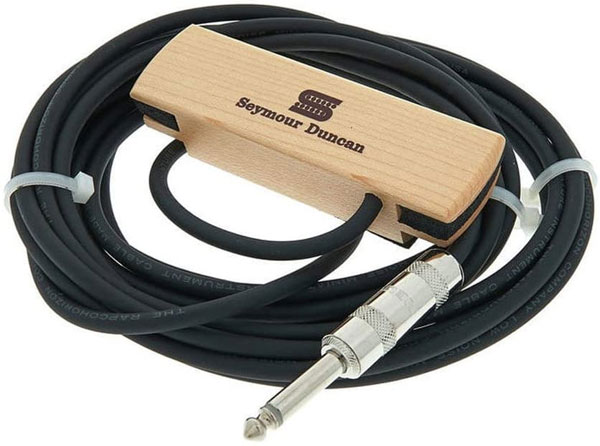
| Estimated price | $60 |
| Type | Magnetic soundhole |
| Design | Passive |
| Preamp | None |
| Cable length | 14 feet |
| Installation | Easy |
My Review: I think that the Woody HC is the perfect pickup for the acoustic guitar. This is because it complements the elegant wood grain of the guitar with the unique characteristics of the pickup. This is especially true if your acoustic guitar also happens to have a light-colored top, such as maple.
The Woody HC is Seymour Duncan’s magnetic soundhole transducer offering that features an advanced hum-canceling technology. You will not get any of that annoying mains hum if you observe a minimum of 30 inches from your external amp or even preamp. This is never a problem because the device already comes with a 14-foot cable for connecting to guitar accessories. Yes, you will still need these devices to play your acoustic like an electric guitar.
If you plug this to a digital recording console, you might be surprised at the bright, clear, shiny, and crisp high notes that it produces. You will also notice the bass notes to be deeper, warmer, and richer. It’s everything you need to transform your ordinary acoustic guitar into a phenomenal electric guitar without having to worry about drilling any hole on your guitar.
Bottom Line: The Seymour Duncan Woody HC may not have the friendliest price among the magnetic types of acoustic guitar pickups. However, it does provide you with a sound quality that very few budget pickups can provide.
9. Amumu SBT-10 Trans-HD
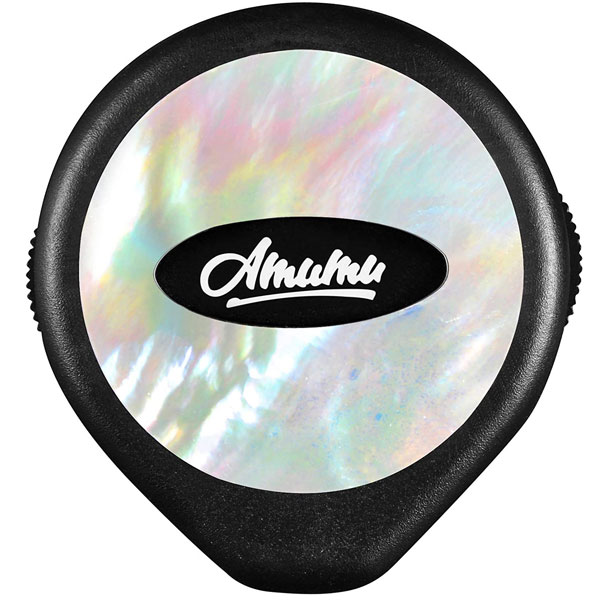
| Estimated price | $25 |
| Type | Contact-vibrational, soundboard transducer |
| Design | Passive |
| Preamp | None |
| Cable length | 10 feet |
| Installation | Easy |
My Review: The SBT-10 Trans-HD works a lot like the HDE P39 in terms of its ability to pick up soundboard vibrations and then converting these into electrical impulses. The only difference is that this Amumu device has a smaller footprint than what HDE offers.
There is another interesting feature of the SBT-10 that the P39 doesn’t have. This device comes with a strap-pin holder that is very useful for retaining the jack. You will not have to worry about the cable dangling from your guitar when you store it. Playing your acoustic guitar is also more convenient because the cable will not hinder your playing movements. That is if your guitar comes with a strap-pin. If it doesn’t, then this feature will be for naught.
It’s quite amazing to see that Amumu not only provides a volume adjustment in its device. This transducer pickup also has an adjustment dial for the tone. This is surprising, considering the pickup has a passive design. The sound that it creates is decent enough to wow your friends as well as the audience of a local talent show. It only requires the correct guitar accessory to help you shape its sound a lot better.
Bottom Line: The Amumu SBT-10 Trans-HD doesn’t have any fancy technology that big-name brands can offer nor the kind of construction that will last decades. However, it does a decent job of turning your acoustic guitar into a performance musical instrument that you can control on the fly.
10. Donner TP-1 Acoustic
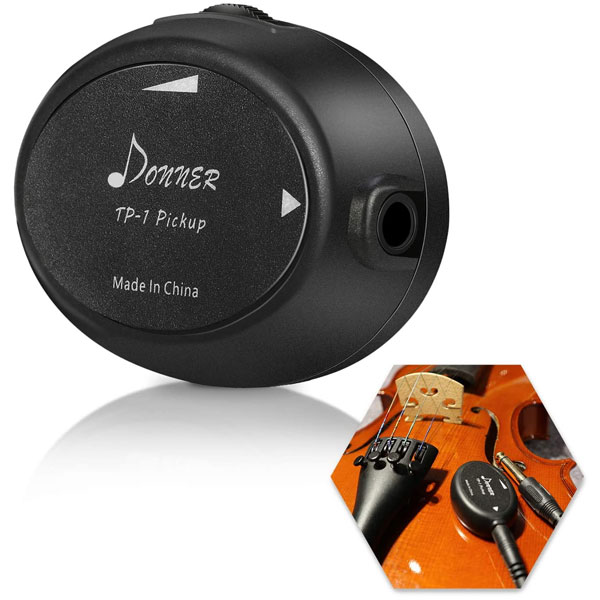
| Estimated price | $15 |
| Type | Piezoelectric contact-vibrational transducer |
| Design | Passive |
| Preamp | None |
| Cable length | 10 feet |
| Installation | Easy |
My Review: The Donner TP-1 is another inexpensive option that can do a decent job of giving your acoustic guitar enough oomph to wow a small crowd. Its soundboard transducer architecture makes it versatile to be used on any string musical instrument that has a soundboard. Mount onto your ukulele, cello, mandolin, or even banjo and this device will give you an instant connection to different electronic music accessories.
Mounting the TP-1 is as easy as peeling the cover of the back and sticking the device on the surface of your guitar top. It is like the HDE P39 in that the TP-1 also has a volume adjustment dial. This is perfect for managing the feedback that may occur if you crank the volume too high. You get a surprisingly clear, not muddy sound from your guitar.
As its price tag suggests, the TP-1 comes with a cheap plastic construction. Make sure to keep this in mind. Don’t expect the device to come with pricey materials.
Bottom Line: You cannot get a contact transducer acoustic guitar pickup that’s as basic as the TP-1. While it is easy to think that this small device has poor sound quality, it is decent enough for beginners to appreciate the performance of an acoustic-electric guitar.
11. Fishman Rare Earth Humbucker
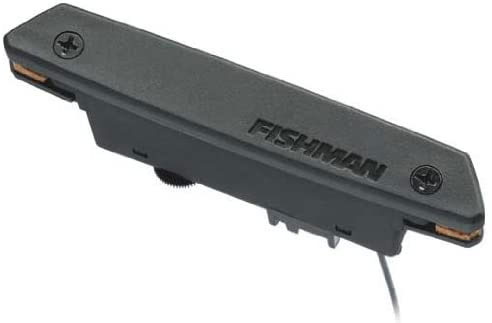
| Estimated price | $190 |
| Type | Combination of magnetic humbucker and active electronic transducer |
| Design | Active, requires 3V lithium or (2) 1.5V LR44 silver oxide batteries |
| Preamp | None |
| Cable length | No available information |
| Installation | Easy to moderate |
My Review: The Rare Earth Humbucker is the more tech-packed brother of the Fishman Neo-D. Both devices use powerful and premium-quality neodymium magnets to produce a magnetic field around the strings of your guitar. Instead of having a single coil, both products feature another coil that cancels the feedback generated by the other coil. This results in an acoustic tone that can surprise even the most seasoned guitar player.
What the Rare Earth has that the Neo-D doesn’t is the Bright Switch. This allows you to toggle between shimmering highs and warm tones. You get to pick the right shape of sound straight from your guitar. This is a multisource system that combines the electric guitar-like performance of magnetic transducers and the remarkable clarity and warmth of an active electronic transducer.
Despite having a soundhole clip-on design, the Rare Earth requires some minor tweaking of your guitar. If you think you want this device to be a permanent fixture on your guitar, then you should get ready to drill a hole. Otherwise, leaving the cable as is should guarantee effortless installation.
Bottom Line: If you’re looking for a cutting-edge acoustic guitar pickup that utilizes a seriously-amped up magnetic transducer, you don’t need to look further than the Rare Earth. It provides one of the nicest tones you can ever get from this type of guitar pickup.
12. Fishman Matrix Infinity
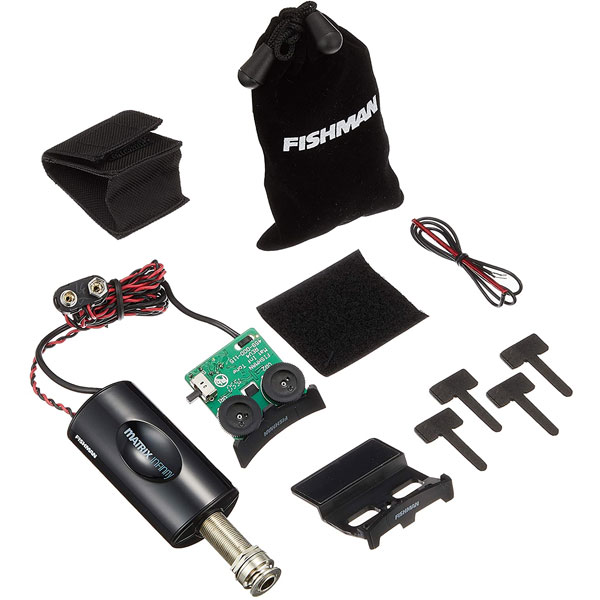
| Estimated price | $180 |
| Type | Under-saddle transducer |
| Design | Active, requires 9V battery |
| Preamp | Yes, volume and tone only |
| Cable length | Not applicable |
| Installation | Moderate to difficult |
My Review: Costing about 10 dollars less than the Fishman Rare Earth, the Matrix Infinity offers a different way of producing an electric guitar-like sound. The Matrix Infinity is an under-saddle type of guitar pickup that is perfect for producing a transparent and clear tone. The string response is also as dynamic as you can ever hope for.
The installation of the Matrix Infinity can be quite tricky as you will need to drill a hole in your guitar. This will provide access to the guitar port that can communicate with your other guitar sound effects pedals, amps, and loudspeakers. I’m quite surprised to see the product information saying that the installation is easy. I guess it is easy for those who have that DIY spirit and with access to the correct tools. Absolute newbies won’t have a clue as to how to connect the different components of the system.
There is a preamp that needs to be mounted along the inner side of the edges of the soundhole. You can adjust the tone and the volume of the Matrix Infinity through this small component.
Bottom Line: Getting the Matrix Infinity into your guitar requires more than a basic knowledge of guitars. Once you have it installed, playing your acoustic guitar would be a lot closer to playing an electric guitar on the stage.
13. L.R. Baggs M1
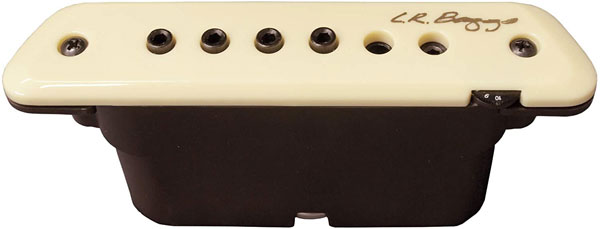
| Estimated price | $200 |
| Type | Magnetic soundhole |
| Design | Active, requires 3V lithium battery |
| Preamp | Yes, volume only |
| Cable length | Not applicable |
| Installation | Easy to moderate |
My Review: I can forgive you for thinking that the M1 looks like any other ordinary guitar pickup that you clip across the soundhole. I thought the same way, too. A closer look at the L.R. Baggs M1 reveals that this magnetic transducer is not your ordinary pickup. It comes with a few neat features that will surprise even advanced guitar players.
The feature that I find most interesting is the adjustable pole pieces. You can pick which strings of your guitar will get amplified using the M1. For example, if you want to amplify only the notes of the low registers, then you can push down the pole pieces of the M1 from the 1st to the 3rd strings. Only the 4th to the 6th strings will sit on the pole pieces. A more efficient use of the adjustable pole pieces is to achieve the perfect balance across different types and gauges of guitar strings.
There’s a small volume adjustment dial on the side of the M1 that is perfect for fine-tuning the sound. This is a neat feature that can address feedback.
Bottom Line: The M1 is almost similar in performance to the L.R. Baggs Anthem, except that it doesn’t have an extensive array of preamp controls. It should still be a great pickup to put into your acoustic guitar.
14. L.R. Baggs Lyric
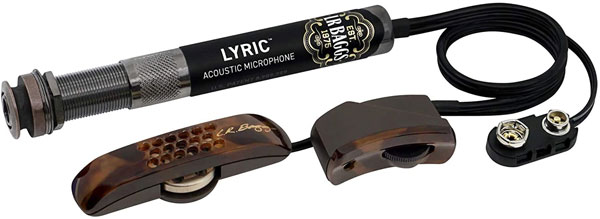
| Estimated price | $200 |
| Type | Microphone |
| Design | Active, requires 9-volt battery |
| Preamp | Yes, volume and microphone presence |
| Cable length | Not applicable |
| Installation | Easy to moderate |
My Review: Remove the Anthem’s Element transducer system and you’re left with an acoustic guitar pickup that only has the TRU MIC technology. This is the Lyric from LR. Baggs. It is essentially an internal microphone for guitars that is powered by a 9-volt battery. Like the Anthem, the Lyric’s TRU MIC has an active noise canceling technology. This addresses the concern of many people about hums and feedbacks.
While I do appreciate the discrete design of the Lyric, I don’t think a novice guitarist will be able to install this without help. First, you need a hole in the guitar body to pass the amp port through. Second, it is crucial to figure out how you intend to mount the battery holder in the guitar. Third, the placement of the preamp is also crucial to ensuring access to its volume and mic presence controls.
What is interesting about this internal microphone is that it can produce sound that is a lot more beautiful and more natural than what piezoelectric devices can muster. The sound is both inspiring and realistic that you will be compelled to play your acoustic guitar endlessly.
Bottom Line: The Lyric is for you if you prefer the amplification capabilities of a microphone. The device provides a more natural acoustic tone, with enough elements to control the shape of the sound produced.
15. L.R. Baggs M80
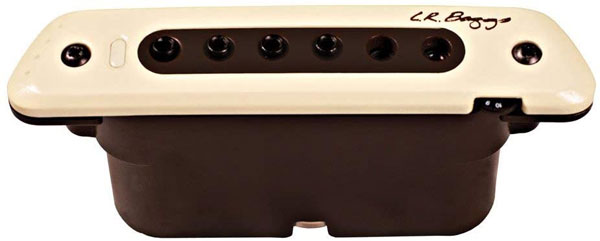
| Estimated price | $250 |
| Type | Magnetic with proprietary free-floating humbucking coil |
| Design | Active-passive, requires CR2032 lithium battery |
| Preamp | Yes, EQ settings, volume, and battery check |
| Cable length | 10 feet |
| Installation | Easy to moderate |
My Review: I’d like to think of the L.R. Baggs M80 as the magnetic humbucker transducer equivalent of the company’s best-selling Anthem. This product doesn’t come with the Element transducer system, nor the TRU MIC technology that you get from the Anthem. It doesn’t mean that the M80 is already a pushover.
On the contrary, I think the M80 has more revolutionary design elements than the Anthem. First, this device has a unique humbucking with a free-floating design. This system not only eliminates feedback. It also functions as a three-dimensional sensor in the guitar body. It captures the unique body resonances of each guitar and blends them with the vibrations coming from the strings. The end-result is a sound that is as faithful to the natural sound of an acoustic guitar.
And get this. The M80 also has a preamp system that allows you to adjust the treble, mid, and bass of your sound, among others. You can also adjust the pole pieces, just like the M1.
Bottom Line: If you’ve got the money and you’re a huge fan of magnetic transducers, you have the perfect deal in the L.R. Baggs M80. Too bad it doesn’t have the TRU MIC system, which would have made this pickup even more awesome.
16. Guild Guitars DeArmond Tone Boss
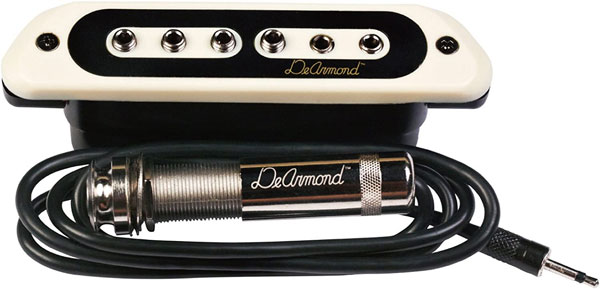
| Estimated price | $85 |
| Type | Magnetic humbucker |
| Design | Passive |
| Preamp | None |
| Cable length | 10 feet |
| Installation | Easy to moderate |
My Review: You can consider the DeArmond Tone Boss as a less expensive equivalent of the L.R. Baggs M1. It comes with a humbucking system that effectively cancels out the noise that create the annoying mains hum. The DeArmond produces a sound that is almost like an electric guitar.
However, this is not the only thing that you will find pleasant in the Tone Boss. This device also comes with interchangeable faceplates. This is great for complementing your playing mood. The pole pieces are also adjustable, just like the M1. This should make it very easy to achieve string balance, regardless of the gauge and type of strings that you have on your guitar.
It is also nice that Guild Guitars presents the DeArmond in a presentable box. You won’t feel ashamed giving this to someone you know as a wonderful gift.
Bottom Line: The Guild Guitars DeArmond Tone Boss is a less expensive alternative to the L.R. Baggs M1. It also has a few neat pluses that can make for a more sensible buy.
17. Ginean Acoustic Guitar Pickup
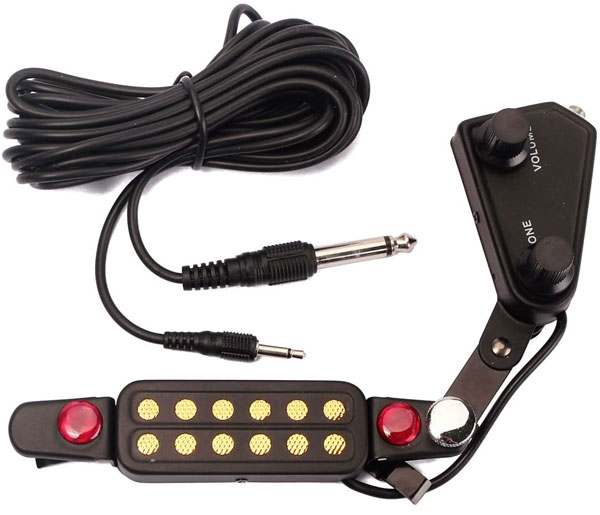
| Estimated price | $15 |
| Type | Magnetic |
| Design | Passive |
| Preamp | Volume, tone |
| Cable length | 10 feet |
| Installation | Easy to moderate |
My Review: There is something in this magnetic transducer acoustic guitar pickup that similarly-priced devices don’t have. That something is a preamp system that is mated to a passively-designed transducer. I find it fascinating that Ginean was able to incorporate a preamp into the basic design of this soundhole-clippable device. While the preamp can only provide controls for tone and volume, I think it is still better than not having any at all.
Installation is easy if you are looking at the Ginean as a temporary solution to your jamming needs. However, if you think of making the system a more permanent fixture in your guitar, then you should be ready to drill a hole somewhere in the body of your guitar.
This is a single-coil system that is quite prone to feedback. However, I was surprised at how minimal the hum is. You can always eliminate feedback if you position your guitar farther away from the amp or the loudspeaker.
Bottom Line: The Ginean Acoustic Guitar Pickup is an inexpensive magnetic transducer that can give you basic controls of both the tone and volume of your guitar sound. It is not a device for serious gigs, but is decent enough for backyard partying with your friends.
Choosing the Right Acoustic Guitar Pickup (Buying Guide)
This section is for newbie guitar players. If you have been playing the acoustic guitar for quite some time and are wondering how you can improve the performance of your instrument, then you might pick a few interesting things in this section, too. Otherwise, you can skip the section and head straight to my list of the best acoustic guitar pickups.
We’ll cover a few basic things about the guitar pickup and how it works. I will not delve on the technical details of such a device. I think what is best is to lay the foundation for the basic understanding of how such a small guitar accessory can improve the performance of your acoustic guitar.
Then, we’ll try to figure out if this is really a device worth installing in your acoustic guitar. I shall also share with you the different types of acoustic guitar pickups, including the pros and cons and what they are good for. Lastly, we’ll round up this section with several tips on how you can choose the pickup that’s right for your acoustic guitar.
Here we go.
What’s a Guitar Pickup?
This is a very small device that serves as a transducer. It can sense or capture the mechanical vibrations that the guitar produces when you strum or pick the strings. The transducer – the guitar pickup – converts these mechanical vibrations into electrical signals. A preamp then amplifies these electrical signals before they get sent to a loudspeaker. This produces a guitar sound that is louder than the actual sound played.
Guitar pickups are what differentiate electric guitars from acoustic guitars. Since a guitar pickup is the first step towards the amplification of guitar sound, an acoustic guitar doesn’t need that anymore. This is because an acoustic guitar already has a sound box that serves to resonate the sound and make it ‘louder’.
Electric guitars don’t have a sound box because they have solid bodies. That is why a guitar pickup is very important to amplify the sound that the guitar makes. If you try to play an electric guitar without turning it on, the sound that it produces is a lot less loud than what an acoustic guitar can offer. Turn it on and you’ve got a loud guitar worthy of headbanging to. That’s the work of the pickup.
Do You Really Need an Acoustic Guitar Pickup?
From our discussion above, it is now apparent who an acoustic guitar pickup is for.
This is a device that is best for guitar players who like their musical instruments to produce a louder sound. For example, you might want to participate in a talent show. You can put a microphone in front of your guitar, while playing your winning piece. Unfortunately, there can be issues with feedback and the sound that your guitar produces may not have the kind of quality you want to win the competition.
The same is true for live performances. Going on stage and having people arrange the mic for you is not only cumbersome. It also gives an impression that you’re not prepared for the gig.
This also applies to playing the guitar with your friends and family or some other small gathering in your house. You will want a guitar that can play loud sounds without having to resort to an external microphone.
That is why installing a pickup in your acoustic guitar is always a great idea in these circumstances.
Another reason why you may want to install an acoustic guitar pickup is that you can enjoy the many amazing sound effects that electric guitars are known for playing. Of course, this entails the purchase of different accessories altogether. You can also connect your acoustic guitar to your compatible mobile device, such as smartphone, laptop, and tablet.
The point is that you will be extending the performance capabilities of your ordinary acoustic guitar. You can buy an acoustic guitar FX pedal, a reverb pedal, a preamp pedal, an equalizer pedal, and a chorus pedal, among others. In short, you will be turning your acoustic guitar into an electric guitar. You can have a music recording and mixing software on your computer and it would be easy to shape the sound coming from your acoustic guitar if it has the right pickup.
Now, if you’re content on playing your guitar by yourself in the comfort of your bedroom or you simply don’t want any of that sound effects, then you clearly don’t need a pickup.
Types of Acoustic Guitar Pickups
I hope by now you already have an idea about how a pickup works and whether you need to get one for your acoustic guitar or not. If you think you need one, then the next item on our agenda is learning the three fundamental types of pickups for acoustic guitars.
Magnetic Pickups
The very first guitar pickups came with a magnetic design. The device consists of a magnet wrapped with copper wire. This produces a magnetic field. There are also pole pieces that help to focus the magnetic field. The steel strings sit on these pole pieces, allowing them to be exposed to the magnetic force of the guitar pick. This magnetizes the guitar string above the pole piece.
Strumming or picking the strings creates a disturbance in the magnetic field in an up-and-down motion. The oscillating magnetic field produces an electric current of about 100 to 300 millivolts in the soundhole pickup’s copper coil. The pickup then connects to a patch cable, which, in turn, connects to an amplifier. This strengthens the electrical signal capable of driving a loudspeaker.
Most magnetic soundhole pickups are mounted on the guitar body. However, you can also connect such a device on the bridge, the pickguard, or even the neck of your acoustic guitar.
There are two fundamental types of magnetic pickups that you can mount on your guitar. One is a single-coil system and the other is a humbucker type.
A single-coil pickup has only one coil structure that consists of a copper wire wrapped several thousand times around the col former or bobbin. It produces a great sound. Unfortunately, single-coil pickups have the tendency to transmit electrical buzz and hum. These ‘hums’ come from other electrical devices and even the main power line as electrical interference. This can affect the overall quality of the sound of the guitar strings.
To address this so-called ‘electrical mains hum’, Joseph Raymond Butts combined two coil structures in 1955 to produce the humbucker pickup. Butts arranged the two coils in such a way that they were wrapped in opposing directions. This created six magnetic poles that have opposing polarities. The arrangement allows the coils to cancel common-mode noise coming from electrical devices. This also doubles the signal strength coming from the strings of the guitar.
The beauty about magnetic soundhole pickups is that you can mount several to your guitar, just like what many legendary rock stars do with their electric guitars. For example, the Fender Stratocaster uses three single-coil pickups arranged on the body of the guitar, while the Ibanez RG often uses a combination of a humbucker, single-coil, and another humbucker pickup.
Of course, I don’t expect you to do this on your acoustic guitar. You can try if you want.
The sound that soundhole magnetic pickups is a lot closer to the sound produced by electric guitars. It has a musical and warm tone. This pickup is best for strumming or flatpicking.
The main advantage of this type of acoustic guitar pickup is the sonic warmth that it provides. It is also a lot easier to control, while also allowing you seamless interaction with different guitar effects. Magnetic pickups are easy to install, requiring only the tightening of a few screws after mounting the device on your guitar.
The problem with magnetic pickups is that they don’t produce the resonance and harmonic complexity of an unplugged acoustic guitar. It is also more prone to feedback. And since it is magnetic, you won’t be able to use this on a nylon-string acoustic guitar.
Transducer Pickups
Transducers come in many forms. The most common types are piezoelectric or under-saddle, soundboard, and vibrational or contact.
Many under-saddle pickups use the piezoelectric system for transforming mechanical signals into electrical ones. Other pickups may use other acoustic guitar systems that essentially work in the same way.
They are called under-saddle because these pickups sit between the saddle and the bridge. They convert guitar string vibrations into electrical signals. These signals can then be amplified to produce a louder guitar sound.
This system is almost impervious to electrical interferences as well as the resonance coming from the guitar body. It also doesn’t pick up ambient sound. This results in a sound that has a more distinctive ‘quack’ and a strong attack. It produces an articulate and bright sound.
The sound that under-saddle pickups create is more focused on the string. It is bright and perfect for classical and fingerstyle guitar players. It does tend to suffer from a ‘quacky’ sound.
Installing an under-saddle pickup can be very tricky. Many of these products require you to remove the saddle to fit the system on top of the bridge, before putting the saddle back in. You need to be very confident in your use of specialty guitar tools to install such a system. Getting a professional install, it for you isn’t a bad idea either.
Another type of transducer is the soundboard transducer. This is typically mounted on the inside surface of the soundboard, often on the underside of the bridge plate. The pickup consists of sensors that keep track of the movements of the guitar’s top soundboard.
Soundboard pickups provide a ‘woody’ tone. It is not the best sound that you will hear. Neither is it the loudest. And if you play your guitar too loud, there is a chance that you will also get an irritating feedback.
The main advantage of soundboard pickups is their ease of installation. All you need is a double-sided adhesive tape and you can easily secure the device on your guitar’s soundboard. It is also less expensive. Because of its low volume characteristics, this is a pickup that is best for smaller performances.
Vibrational or contact pickups work like a Piezo system. Where the Piezo system only picks up string vibrations, contact systems also pick up vibrations coming from the guitar body. This results in a sound that is fuller than what the Piezo system produces. It has more of the bass and lower-mid registers.
The problem with contact or vibrational pickups is that they are not as immune to feedback as Piezo systems. It is worth pointing out that these systems also pick up both the vibrations and excess resonances from the body. These pickups can also be tricky to find the perfect fit in a mix.
Internal Microphones
The third type of acoustic guitar pickup is the simplest to install and use. Internal microphones work like any standard microphone. The only difference is that you will place this device in the guitar body. This allows the microphone to pick up the sound of your guitar when you play it.
The mic can pick up the natural percussiveness and resonances of your guitar a lot better than magnetic or piezoelectric systems. It is ideal for those who want to recreate the natural tone of their acoustic guitar. It is perfect for strumming or flatpicking.
The main issue with an internal mic is feedback. Where you position the mic inside the guitar body can also have an impact on the quality of the sound produced. Also, mics don’t produce as loud a sound as the other two types of pickups.
Most of the internal mics sold for acoustic guitars come as part of a Piezo system. In such cases, installation can be as tricky as that of the piezoelectric pickup.
Questions to Ask Yourself When Choosing the Right Pickup for Your Acoustic Guitar
You should not have a clear idea of the type of pickup to get for your acoustic guitar. If not, then you can try answering the following questions to help you narrow down your choices.
What’s Your Budget?
Acoustic guitar pickups may be small, but they do command a respectable price. The price can be as wide-ranging as acoustic guitars. Inexpensive ones can set you back for less than fifty dollars, maybe even $10. High-end systems typically sell for at least $300. You might want to ask yourself how much you’re willing to pay for such a device.
Does the Pickup Require Modification of the Acoustic Guitar?
The different types of guitar pickups require different ways of installation or mounting. There are systems that only require the removal of the strings and the attachment of the pickup on the body to serve as a platform for the strings to sit on.
Some systems allow you to mount them on the underside of the soundboard, using nothing else than an ordinary adhesive tape. There are products, however, that require you to drill into the body or the soundboard of your acoustic guitar to create a more permanent position for the pickup.
There are also acoustic guitar pickups that require modification of the sound hole or even the addition of other devices. You will need to perform any of these solutions to address the issue of feedback and other unwanted sounds coming from the guitar and the environment.
Does it Come with a Preamp?
Most of the piezoelectric systems already come with a preamp. Some acoustic guitar pickups may not have this element.
If it does come with a preamp, make sure to check what controls the preamp provides. Most will have the basic controls for the tone and volume. Others will have EQ sliders that allow you to adjust the treble, middle, and bass. If your system comes with two different pickups, then the preamp should have blend controls.
It also makes sense to check for onboard digital tuners and feedback controls. You will often find these preamp features in high-end models of acoustic guitar pickups. Expect to pay a premium for such features.
Also check the mounting options for the preamp. Most systems are easily tucked into the guitar’s sound hole. More advanced systems require you to mount them on the side of the acoustic guitar. There are also preamps that serve as external devices.
Is it Active or Passive?
An active pickup requires electricity for it to be able to boost its output. The electricity comes from an external source, often in the form of a 9-volt battery. These pickup systems are perfect for playing heavy metal, fusion, and funk music because of the need for a more powerful acoustic output.
Conventional acoustic guitar pickups, on the other hand, are passive. An example of this is a magnetic soundhole pickup. It doesn’t need electricity to convert the vibrations into electrical signals. The movement of the strings is enough to generate an electromagnetic signal.
Since an active pickup system runs on electricity, it does require more care than a passive system. You will have to protect the system from moisture ingress to help safeguard the integrity of the power source; something that you will never have to worry with a passive system.
Acoustic guitar pickups are simple yet very remarkable devices. They can instantly transform an ordinary-sounding guitar into a high-performance gig guitar. Connect it to guitar pedals, your computer, or even your mobile device. It can open a lot of opportunities for you, allowing you to unleash your musical creativity.
You can enjoy all these things and many more only if you choose the right pickup for your acoustic guitar and your needs.
What are you waiting for? Pick any of the 17 acoustic guitar pickups I shared with you in this article or use the comprehensive guide to buying one. Either way, you’ll be glad to put this small gadget in your acoustic guitar and let your innate guitar playing skills take center stage.

My name is Chris and I’ve had a passion for music and guitars for as long as I can remember. I started this website with some of my friends who are musicians, music teachers, gear heads, and music enthusiasts so we could provide high-quality guitar and music-related content.
I’ve been playing guitar since I was 13 years old and am an avid collector. Amps, pedals, guitars, bass, drums, microphones, studio, and recording gear, I love it all.
I was born and raised in Western Pennsylvania. My background is in Electrical Engineering, earning a Bachelor’s degree from Youngstown State University. With my engineering experience, I’ve developed as a designer of guitar amplifiers and effects. A true passion of mine, I’ve designed, built, and repaired a wide range of guitar amps and electronics. Here at the Guitar Lobby, our aim is to share our passion for Music and gear with the rest of the music community.
